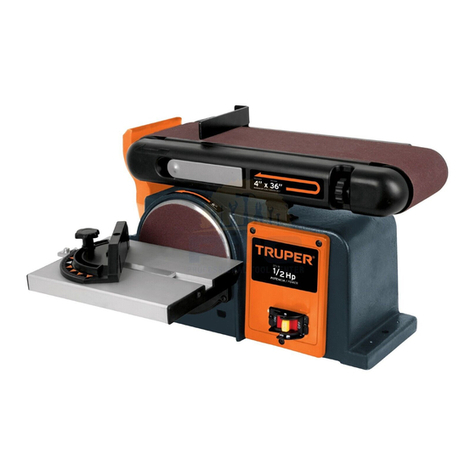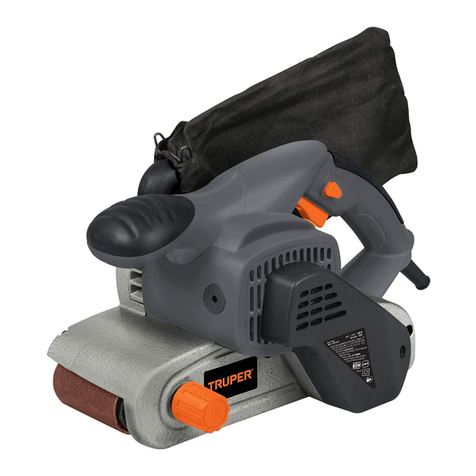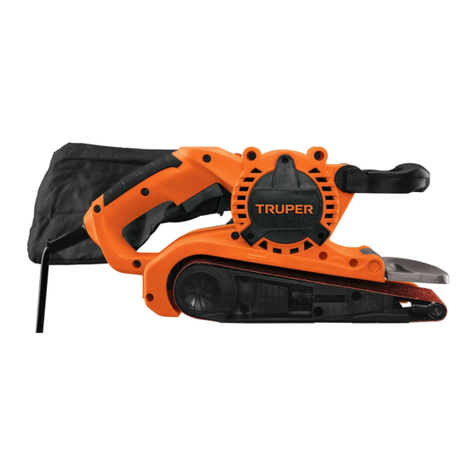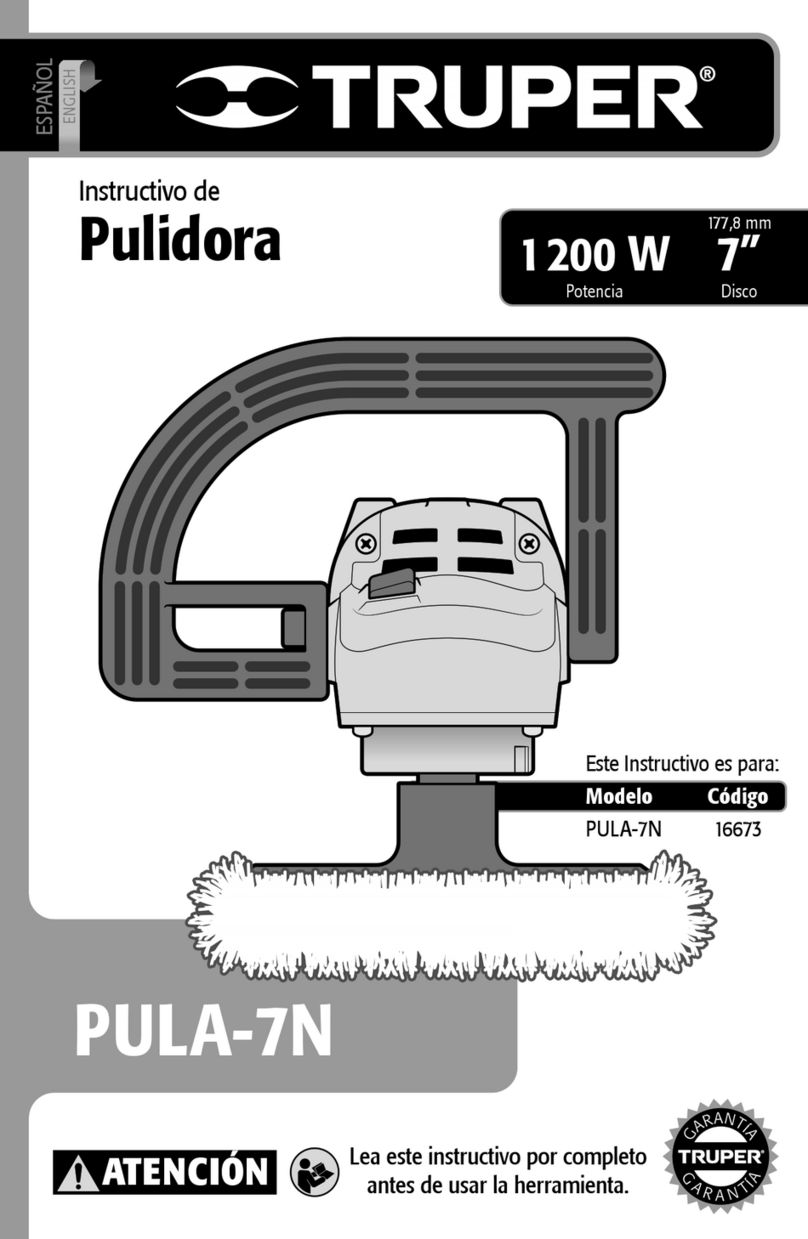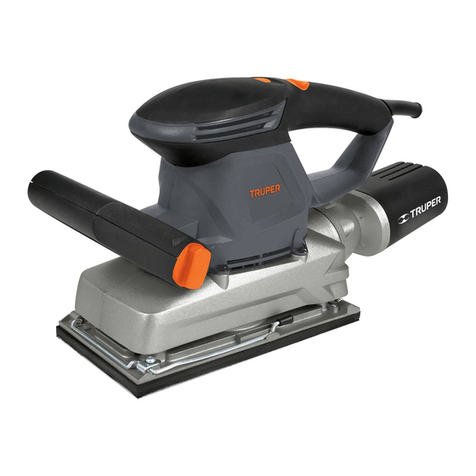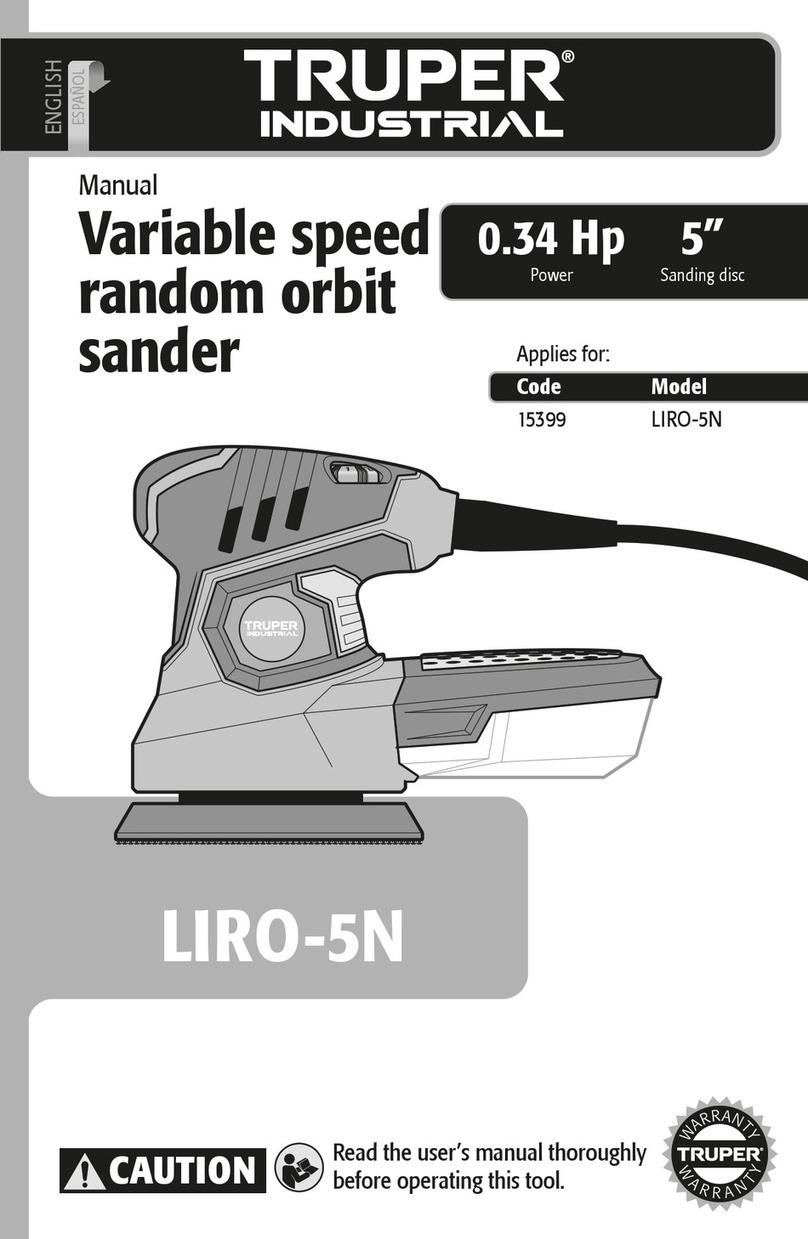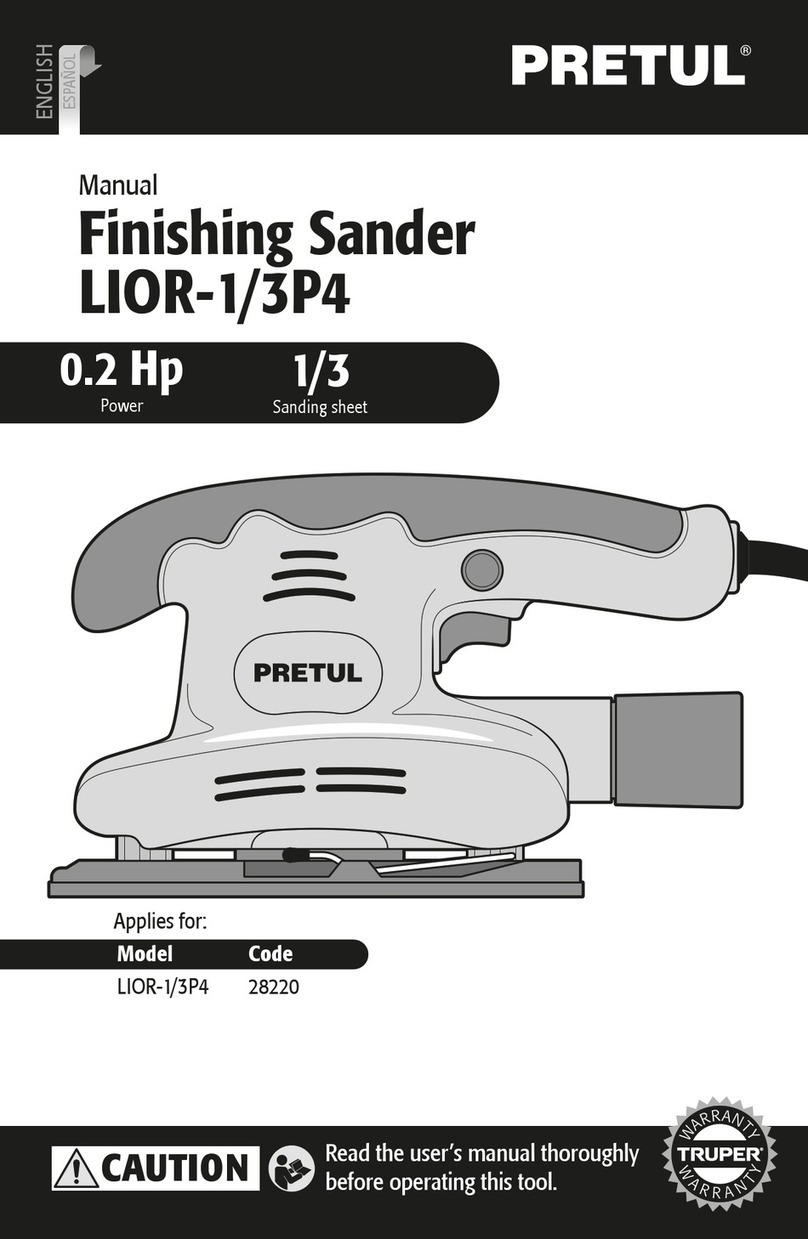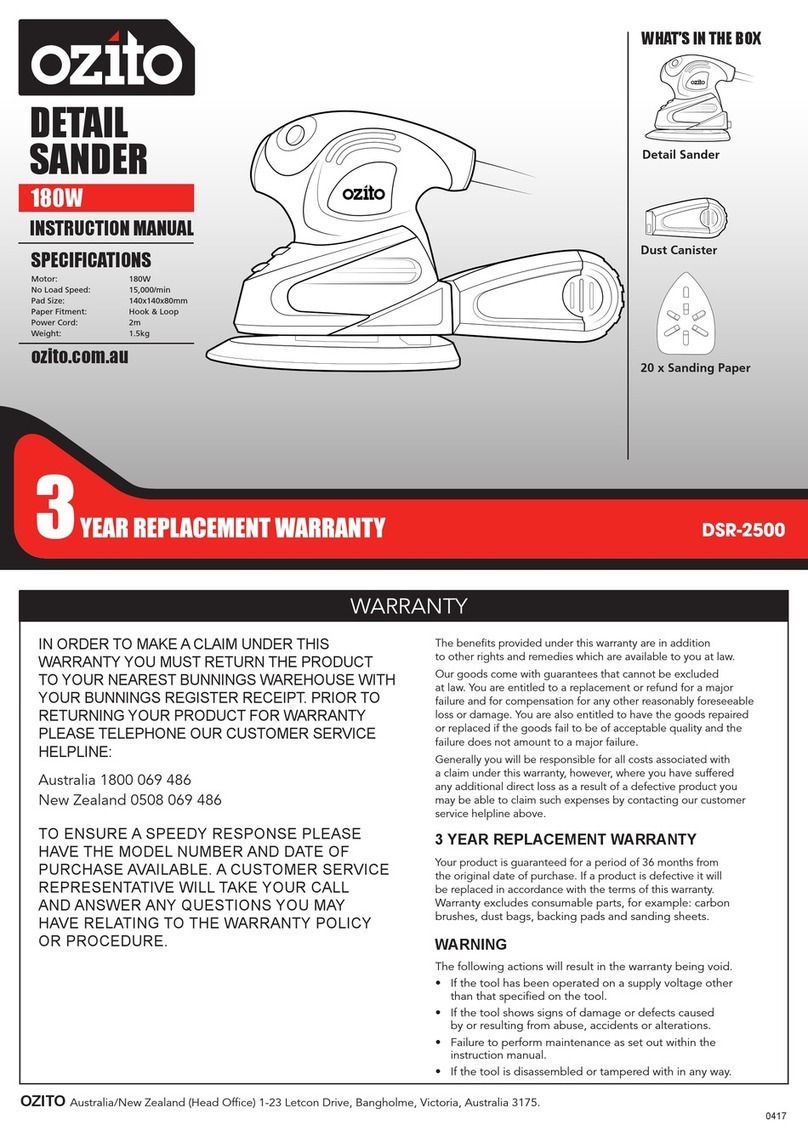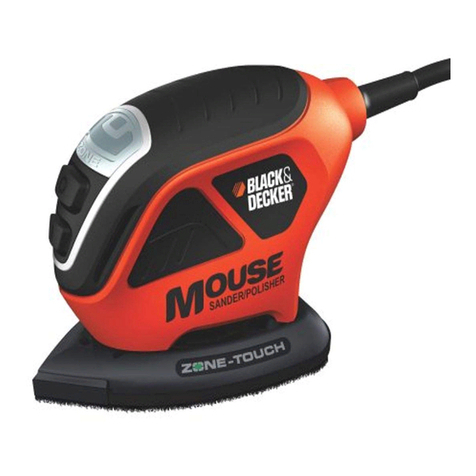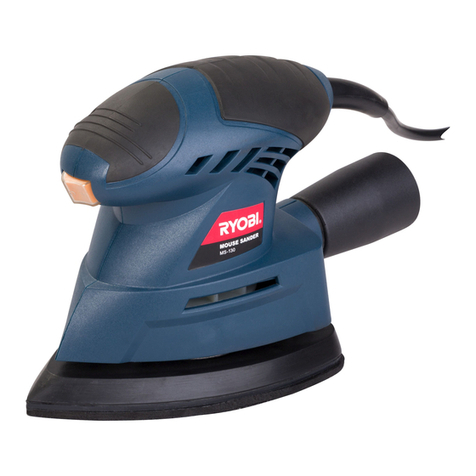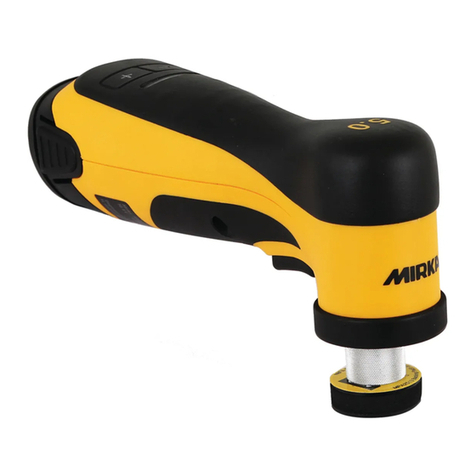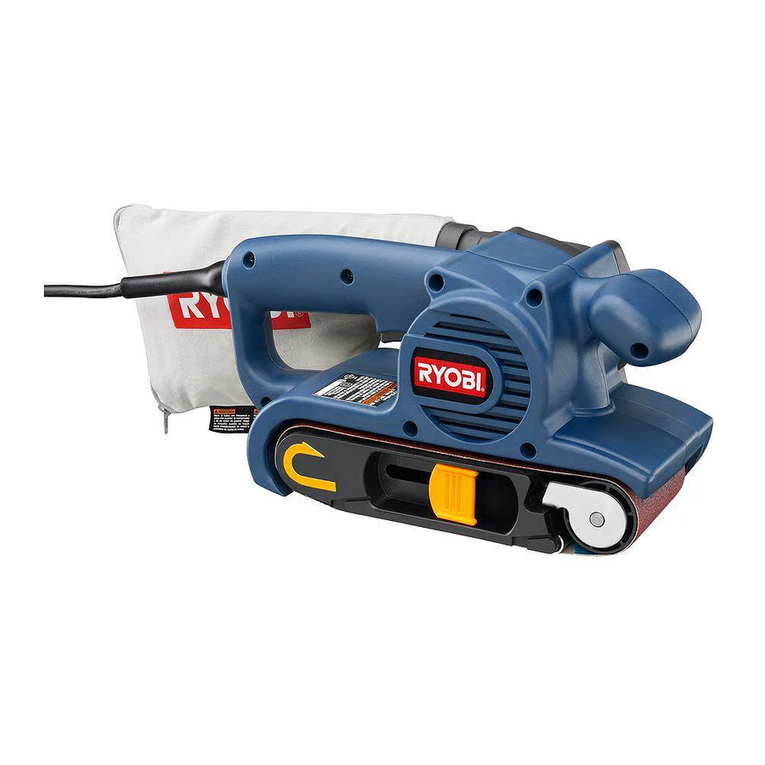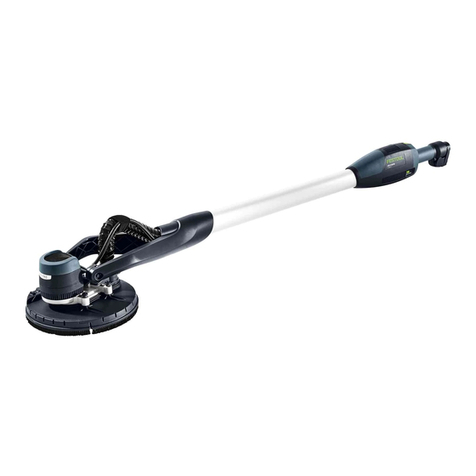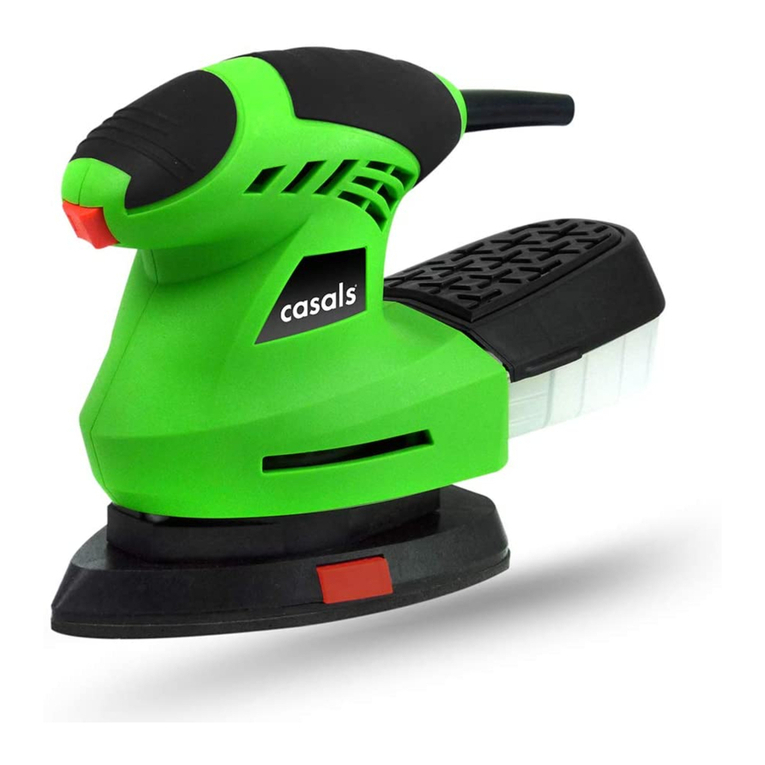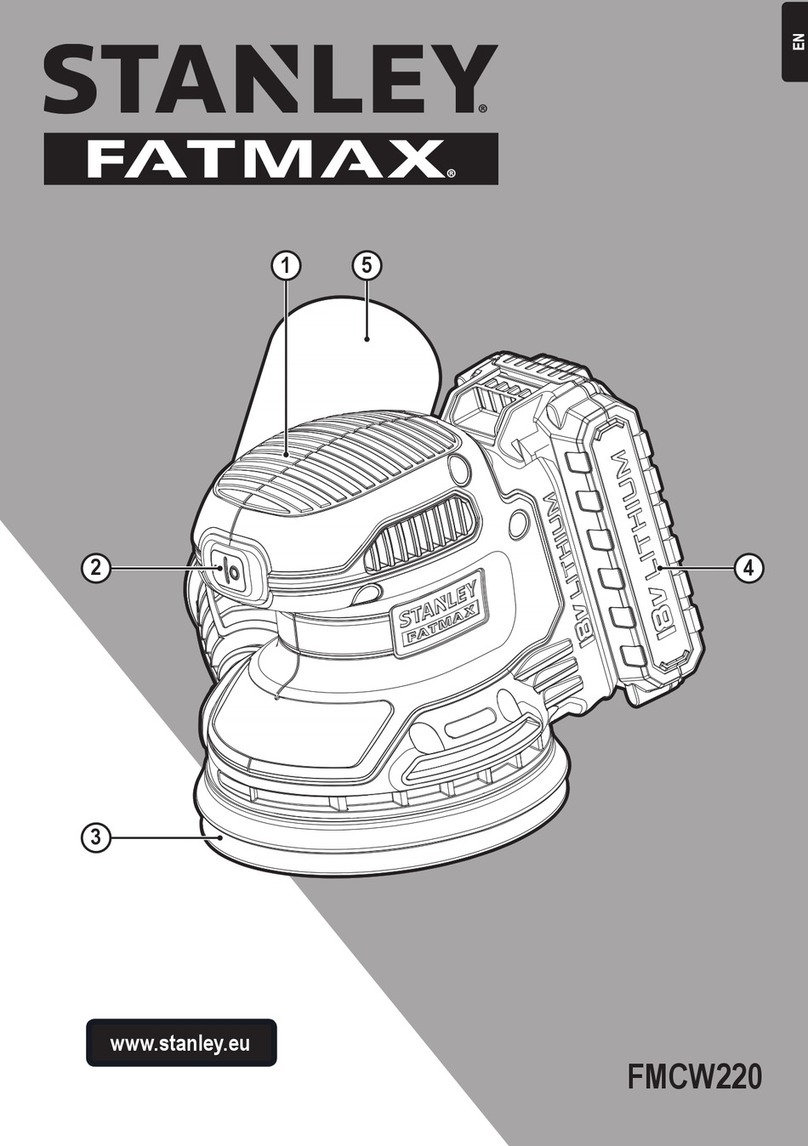Truper LIBA-4X24N3 User manual

Manual
Belt sander
LIBA-4X24N3
Model Code
LIBA-4X24N3
Applies for:
100370
Power Sanding belt
4”x 24”1200 W
ENGLISH
ESPAÑOL
CAUTION Read this manual thoroughly
before using the tool.

2
Technical data
Power requirements
General power tool safety warnings
Safety warnings for belt sander
Parts
Start up
Maintenance
Authorized Service Centers
Warranty policy
3
3
4
5
5
6
8
9
10
LIBA-4X24N3
ENGLISH
CAUTION
Contents
Keep this manual for future references.
The illustrations in this manual are for reference
only. They might be different from the real tool.
To gain the best performance of
the tool, prolong the duty life,
make the Warranty valid if
necessary, and to avoid hazards
of fatal injuries please read and
understand this Manual before
using the tool.

IP Grade IP20
3
LIBA-4X24N3
100370
4” x 24”
Class II
60 Hz
Belt sander
16 AWG x 2C with insulating temperature of 221 °F
1200 W
Code
Description
Belt
Voltage
Frequency
9,4 A
Current
Power
50 minutes work per 20 minutes idle. Maximum 6 hours per day.
Duty cycle
Conductors
Insulating
Power cord grips used in this product: Type “Y”.
Build quality: Reinforced insulation.
Thermal insulation on motor winding: Class E.
127 V
Technical data
Power requirements
ENGLISH
Tools with double insulation and reinforced insulation are
equipped with a polarized plug (one prong is wider than the other). This plug will
only fit in the right way into a polarized outlet. If the plug cannot be introduced into
the outlet, reverse the plug. If it still doesn’t fit, call a qualified electrician to install
for you a polarized outlet. Do not alter the plug in any way. Both types of insulation
eliminate the need of both a grounded third power cord with three prongs or a
grounded power connection.
When using an extension cable, verify the gauge is enough for
the power that your product needs. A lower gauge cable will cause voltage drop in the line, resulting in power loss and
overheating. The following table shows the right size to use depending on cable’s length and the ampere capability
shown in the tool’s nameplate. When in doubt use the next higher gauge.
WARNING
WARNING
from 0 A and up to 10 A
from 10 A and up to 13 A
from 13 A and up to 15 A
from 15 A and up to 20 A
18 AWG(*)
16 AWG
14 AWG
8 AWG
16 AWG
14 AWG
12 AWG
6 AWG
3 (one grounded)
from 6 ft to 49 ft | higher than 49 ft
Ampere
Capacity Number of
Conductors Extension gauge
*It is safe to use only if the extensions have a built-in artifact for over current protection.
AWG = American Wire Gauge. Reference: NMX-J-195-ANCE
WARNING
WARNING Avoid the risk of electric shock or severe injury. When the power cable gets damaged
it should only be replaced by the manufacturer or at a Authorized Service Center.
The build quality of the electric insulation is altered if spills or liquid gets into the tool while in use.
Do not expose to rain, liquids and/or dampness.
Before gaining access to the terminals all power sources should be disconnected.
WARNING When operating power tools outdoors, use a grounded
extension cable labeled “For Outdoors Use”. These extensions are specially designed for
operating outdoors and reduce the risk of electric shock.
500 m/min
Speed

4ENGLISH
This tool is in compliance with
the Official Mexican Standard
(NOM - Norma Oficial Mexicana).
Work area
Keep your work area clean, and well lit.
Cluttered and dark areas may cause accidents.
Never use the tool in explosive atmospheres, such as in the
presence of flammable liquids, gases or dust.
Sparks generated by power tools may ignite the flammable material.
Keep children and bystanders at a safe distance while operating
the tool.
Distractions may cause loosing control.
Electrical Safety
The tool plug must match the power outlet. Never modify
the plug in any way. Do not use any adapter plugs with
grounded power tools.
Modified plugs and different power outlets increase the risk of electric shock.
Avoid body contact with grounded surfaces, such as pipes,
radiators, electric ranges and refrigerators.
The risk of electric shock increases if your body is grounded.
Do not expose the tool to rain or wet conditions.
Water entering into the tool increases the risk of electric shock.
Do not force the cord. Never use the cord to carry, lift or unplug
the tool. Keep the cord away from heat, oil, sharp edges or
moving parts.
Damaged or entangled cords increase the risk of electric shock.
When operating a tool outdoors, use an extension cord suitable
for outdoor use.
Using an adequate outdoor extension cord reduces the risk of electric shock.
If operating the tool in a damp location cannot be avoided, use
a ground fault circuit interrupter (GFCI) protected supply.
Using a GFCI reduces the risk of electric shock.
Personal safety
Stay alert, watch what you are doing and use common sense
when operating a tool. Do not use a power tool while you are
tired or under the influence of drugs, alcohol or medication.
A moment of distraction while operating the tool may result in personal injury.
Use personal protective equipment. Always wear eye
protection.
Protective equipment such as safety glasses, anti-dust mask, non-skid shoes,
hard hats and hearing protection used in the right conditions significantly
reduce personal injury.
Prevent unintentional starting up. Ensure the switch is in the
“OFF” position before connecting into the power source and /
or battery as well as when carrying the tool.
Transporting power tools with the finger on the switch or connecting power
tools with the switch in the “ON” position may cause accidents.
Remove any wrench or vice before turning the power tool on.
Wrenches or vices left attached to rotating parts of the tool may result in personal
injury.
Do not overreach. Keep proper footing and balance at all times.
This enables a better control on the tool during unexpected situations.
Dress properly. Do not wear loose clothing or jewelry. Keep
hair, clothes and gloves away from the moving parts.
Loose clothes or long hair may get caught in moving parts.
If you have dust extraction and recollection devices connected
onto the tool, inspect their connections and use them correctly.
Using these devices reduce dust-related risks.
Power Tools Use and Care
Do not force the tool. Use the adequate tool for your
application.
The correct tool delivers a better and safer job at the rate for which it was designed.
Do not use the tool if the switch is not working properly.
Any power tool that cannot be turned ON or OFF is dangerous and should be
repaired before operating.
Disconnect the tool from the power source and / or battery
before making any adjustments, changing accessories or
storing.
These measures reduce the risk of accidentally starting the tool.
Store tools out of the reach of children. Do not allow persons
that are not familiar with the tool or its instructions to
operate the tool.
Power tools are dangerous in the hands of untrained users.
Service the tool. Check the mobile parts are not misaligned or
stuck. There should not be broken parts or other conditions that
may affect its operation. Repair any damage before using the
tool.
Most accidents are caused due to poor maintenance to the tools.
Keep the cutting accessories sharp and clean.
Cutting accessories in good working conditions are less likely to bind and are
easier to control.
Use the tool, components and accessories in accordance with
these instructions and the projected way to use it for the type of
tool when in adequate working conditions.
Using the tool for applications different from those it was designed for, could
result in a hazardous situation.
Service
Repair the tool in a Authorized Service Center
using only identical spare parts.
This will ensure that the safety of the power tool is maintained.
General power tool
safety warnings
WARNING! Read carefully all safety warnings and instructions listed below. Failure to comply with any of
these warnings may result in electric shock, fire and / or severe damage. Save all warnings and instructions for
future references.

Parts
Continuous
use button
Front roller
Alignment
knob
Handle
Auxiliary
handle
Dust
collecting
pouch
Dust
extracting
duct
Tension lever
of the sander belt
Traction roller
Power
cord
Abrassive belt
Switch
5
ENGLISH
• Observe the applicable regulations
when sanding painted surfaces. Use special care when the
paint is lead-based.
• To have a safe work environment remove dust and any
other debris. When possible use a vacuum cleaner or a
dust recollection extractor.
• Everybody within the work area shall
wear professional breathing devices to be protected
against dust and smoke generated when sanding.
• Do not use this tool to sand pieces containing
magnesium.
• Wear brand
professional breathing devices and cartridges suitable for
working with paint dust and vapors. Regular painting
masks do not offer that type of protection.
• Children and pregnant women shall
not enter the work area.
• Hold the tool by the isolated
grabbing surfaces. The belt could make contact with its
own power cord. Making contact with a power
conducting cable makes the metallic parts in the tool will
also be charged with power and send an electric shock to
the operator.
• Wear adequate clothes. Lose
clothes, jewelry or long hair could get caught in the
moving parts.
Wear adequate clothing
Caution with electric shock
Cautions with dust and residues
Safety warnings for
belt sanders
CAUTION
CAUTION
CAUTION
WARNING
WARNING
WARNING
Power Cord
Protector
Carbon brushes cover (x2)
Clamp
Sander
base

• Pull the belt tension lever until it stops.
• Choose the abrasive belt with the required grain and set
it straight and centered around the rollers. Double check
the arrow in the belt inner side points onto the same
direction that the sander in the belt sander.
• Push the lever to set it into its initial position.
• Turn on the sander to make the belt run. While
the tool is running but not making contact with any
surface turn the aligning knob until the belt runs
continuously in a straight way.
The belt shall be adjusted tightly to the
sander base. It shall not be loose.
CAUTION
Start up
Dust collecting
bag
6
Belt set up
• Intermittent operation: Connect the plug to the power
outlet. Press switch (A) to start the belt sander. To interrupt
using just release the switch.
• Continuous Operation: Connect the plug to the power
outlet. Press switch (A) and block it by pushing the
continuous use button (B). To stop, press and then release
the switch.
Turn On and operation control
• To prevent dust from accumulating in the belt
sander and the work place use the dust extraction
duct altogether with the collecting pouch or a
vacuum system if needed.
• Remove the dust bag when it is half empty and
pull out the fastener (C). Pour out the dust and pat
the bag to remove the dust sticked on the inner
bag, or it will influence the following dust
collecting.
Dust collection
C
ENGLISH
43
1
2
A
B

7
Start up
ENGLISH
• To work on ferrous metal, like steel, stainless steel, iron,
etc., use rough or fine grain belts, regarding the desired
finish. Non-ferrous metal such as aluminum, tin-plate
soldering, brass, bronze, etc., can also be sanded.
• To minimize the load and prolong the belts’ working time
use some lubricant for sanding, polishing, or for satin finish
of metals. Just rub the lubricant onto the belt every now
and then. Also, you can use SAE No. 10 or 20 lubricant oil
to assure a smooth and scratch-less surface.
Metal finish
sanding belts
• To prevent striation of the piece start sanding with the
sander running.
• Keep the sander moving to get a smooth and even job.
• Sanding consists in a backward and forward movement.
Most of the job is made with the traction movement.
• Do not force the tool against the work piece. The
sander’s own weight generates enough pressure to make a
good job. Too much pressure will tear the sander’s grain,
diminishing the sanding efficiency.
• Sand slowly and systematically.
• When you stop, raise the sander from the work piece
before turning it off.
Sanding
• Assure you are selecting brand
sanding belts with the right grain.
• For the initial sanding on an unfinished piece of wood
use a belt with rough or very rough grain. Sand along the
grain. Should the wood is uneven o to hard, sand
diagonally (across the grain). Use care to prevent striation.
• After the preliminary operation, change the belt. Use a
medium grain belt and sand along the grain. This will give
a relatively smooth an even finish.
• For the final finish set a fine grain belt. Always sand along
the grain to remove scratches left by the rougher belts. For
a good finish use long and light passes.
• As a final touch, the experts usually set a fine sanding
belt used to get a smooth surface, to fill, seal, plane or
spray.
Wood finish
• The belt sander also removes old paint, varnish or
lacquer. Please use the safety measures mentioned before.
However, if the paneling is made of several layers, remove
as much material as possible with a paint solvent or
varnish remover before using the belt sander. Use a
hand-scratcher to remove residues left by the solvent.
Allow the surface to dry completely before sanding.
• For a fast removal, start with a rough grain belt.
• When you can see the raw material change to a medium
grain belt to prevent from scratching it. Use short and light
passes moving the sander quickly.
• Pay attention that excessive pressure or constantly
sanding on the same spot will burn the panel.
Finishing panels
Grain Type Applications
36
40
50
60
80
100
120
150
180
Extra rough
Extra rough
Rough
Rough
Medium
Medium
Fine
Fine
Extra fine
Super-fast removal
of material.
Fast removal of material
and sanding to shape wood.
Final sanding or to clean
surfaces before painting or sealing.
Final sanding or
after sealing.
Moderate removal of material.
Eliminate superficial
imperfections.

8ENGLISH
Maintenance
• Keep the motor housing ventilation slots clean and
uncovered.
• Apply compressed air after each use.
• In case of malfunctioning go only to a
Authorized Service Center
Cleaning and care
Carbon brush replacement
• Replace worn (burnt, broken or smaller than 0.19” long)
carbon brushes. Use new carbons.
• When replacing carbons always replace both carbons at
the same time.
• To access the worn carbons, first remove the carbon´s
cover with the help of a flat screwdriver
• Place the new carbons (They should fall into the carbon
holders easily and slide without getting stuck).
• Place the cover again and allow the machine to run for a
few minutes without workload so that the carbon brushes
adjust better.
• Use only original spare carbon
brushes, designed specifically with the right strength and
electric resistance for each type of motor. Carbon brushes
with different specifications may damage the motor.

9
ENGLISH
In the event of any problem contacting a Service Center, please see our webpage www.truper.com to get an
updated list, or call our toll-free number 800 690-6990 or 800 0187-8737 to get information about the
nearest Authorized Service Center.
Authorized Service Centers
AGUASCALIENTES
BAJA
CALIFORNIA SUR
CAMPECHE
CHIAPAS
CHIHUAHUA
MEXICO
CITY
COAHUILA
COLIMA
DURANGO
ESTADO DE
MÉXICO
GUANAJUATO
GUERRERO
HIDALGO
JALISCO
MICHOACÁN
MORELOS
NAYARIT
DE TODO PARA LA CONSTRUCCIÓN
GRAL. BARRAGÁN #1201, COL. GREMIAL, C.P. 20030,
AGUASCALIENTES, AGS. TEL.: 449 994 0537
SUCURSAL TIJUANA
AV. LA ENCANTADA, LOTE #5, PARQUE INDUSTRIAL EL
FLORIDO II, C.P 22244, TIJUANA, B.C.
TEL.: 664 969 5100
FIX FERRETERÍAS
FELIPE ÁNGELES ESQ. RUIZ CORTÍNEZ S/N, COL. PUEBLO
NUEVO, C.P. 23670, CD. CONSTITUCIÓN, B.C.S.
TEL.: 613 132 1115
TORNILLERÍA Y FERRETERÍA AAA
AV. ÁLVARO OBREGÓN #324, COL. ESPERANZA
C.P. 24080 CAMPECHE, CAMP. TEL.: 981 815 2808
FIX FERRETERÍAS
AV. CENTRAL SUR #27, COL. CENTRO, C.P. 30700,
TAPACHULA, CHIS. TEL.: 962 118 4083
SUCURSAL CHIHUAHUA
AV. SILVESTRE TERRAZAS #128-11, PARQUE INDUSTRIAL
BAFAR, CARRETERA MÉXICO CUAUHTÉMOC, C.P. 31415,
CHIHUAHUA, CHIH. TEL. 614 434 0052
FIX FERRETERÍAS
EL MONSTRUO DE CORREGIDORA, CORREGIDORA # 22,
COL. CENTRO, C.P. 06060, CUAUHTÉMOC, CDMX.
TEL: 55 5522 5031 / 5522 4861
SUCURSAL TORREÓN
CALLE METAL MECÁNICA #280, PARQUE INDUSTRIAL
ORIENTE, C.P. 27278, TORREÓN, COAH.
TEL.: 871 209 68 23
BOMBAS Y MOTORES BYMTESA DE MANZANILLO
BLVD. MIGUEL DE LA MADRID #190, COL. 16 DE
SEPTIEMBRE, C.P. 28239, MANZANILLO, COL.
TEL.: 314 332 1986 / 332 8013
TORNILLOS ÁGUILA, S.A. DE C.V.
MAZURIO #200, COL. LUIS ECHEVERRÍA, DURANGO,
DGO.TEL.: 618 817 1946 / 618 818 2844
SUCURSAL CENTRO JILOTEPEC
AV. PARQUE INDUSTRIAL #1-A, JILOTEPEC, C.P. 54240,
JILOTEPEC, EDO. DE MÉX.
TEL: 761 782 9101 EXT. 5728 Y 5102
CÍA. FERRETERA NUEVO MUNDO S.A. DE C.V.
AV. MÉXICO - JAPÓN #225, CD. INDUSTRIAL, C.P. 38010,
CELAYA, GTO. TEL.: 461 617 7578 / 79 / 80 / 88
CENTRO DE SERVICIO ECLIPSE
CALLE PRINCIPAL MZ.1 LT. 1, COL. SANTA FE, C.P. 39010,
CHILPANCINGO, GRO. TEL.: 747 478 5793
FERREPRECIOS S.A. DE C.V.
LIBERTAD ORIENTE #304 LOCAL 30, INTERIOR DE PASAJE
ROBLEDO, COL. CENTRO, C.P. 43600, TULANCINGO,
HGO. TEL.: 775 753 6615 / 775 753 6616
SUCURSAL GUADALAJARA
AV. ADOLFO B. HORN # 6800, COL: SANTA CRUZ DEL
VALLE, C.P.: 45655, TLAJOMULCO DE ZUÑIGA, JAL.
TEL.: 33 3606 5285 AL 90
FIX FERRETERÍAS
AV. PASEO DE LA REPÚBLICA #3140-A, COL.
EX-HACIENDA DE LA HUERTA, C.P. 58050, MORELIA,
MICH. TEL.: 443 334 6858
FIX FERRETERÍAS
CAPITÁN ANZURES #95, ESQ. JOSÉ PERDIZ, COL.
CENTRO, C.P. 62740, CUAUTLA, MOR.
TEL.: 735 352 8931
HERRAMIENTAS DE TEPIC
MAZATLAN #117, COL. CENTRO, C.P. 63000, TEPIC, NAY.
TEL.: 311 258 0540
SUCURSAL MONTERREY
CARRETERA LAREDO #300, 1B MONTERREY PARKS,
COLONIA PUERTA DE ANÁHUAC, C.P. 66052, ESCOBEDO,
NUEVO LEÓN, TEL.: 81 8352 8791 / 81 8352 8790
FIX FERRETERÍAS
AV. 20 DE NOVIEMBRE #910, COL. CENTRO, C.P. 68300,
TUXTEPEC, OAX. TEL.: 287 106 3092
SUCURSAL PUEBLA
AV PERIFÉRICO #2-A, SAN LORENZO ALMECATLA,
C.P. 72710, CUAUTLACINGO, PUE.
TEL.: 222 282 8282 / 84 / 85 / 86
ARU HERRAMIENTAS S.A DE C.V.
AV. PUERTO DE VERACRUZ #110, COL. RANCHO DE
ENMEDIO, C.P. 76842, SAN JUAN DEL RÍO, QRO.
TEL.: 427 268 4544
FIX FERRETERÍAS
CARRETERA FEDERAL MZ. 46 LT. 3 LOCAL 2, COL EJIDAL,
C.P. 77710 PLAYA DEL CARMEN, Q.R.
TEL.: 984 267 3140
FIX FERRETERÍAS
AV. UNIVERSIDAD #1850, COL. EL PASEO, C.P. 78320,
SAN LUIS POTOSÍ, S.L.P. TEL.: 444 822 4341
SUCURSAL CULIACÁN
AV. JESÚS KUMATE SUR #4301, COL. HACIENDA DE LA
MORA, C.P. 80143, CULIACÁN, SIN.
TEL.: 667 173 9139 / 173 8400
FIX FERRETERÍAS
CALLE 5 DE FEBRERO #517, SUR LT. 25 MZ. 10, COL.
CENTRO, C.P. 85000, CD. OBREGÓN, SON.
TEL.: 644 413 2392
SUCURSAL VILLAHERMOSA
CALLE HELIO LOTES 1, 2 Y 3 MZ. #1, COL. INDUSTRIAL,
2A ETAPA, C.P. 86010, VILLAHERMOSA, TAB.
TEL.: 993 353 7244
VM ORINGS Y REFACCIONES
CALLE ROSITA #527 ENTRE 20 DE NOVIEMBRE Y GRAL.
RODRÍGUEZ, FRACC. REYNOSA, C.P. 88780, REYNOSA,
TAMS. TEL.: 899 926 7552
SERVICIOS Y HERRAMIENTAS INDUSTRIALES
PABLO SIDAR #132, COL . BARRIO DE SAN BARTOLOMÉ,
C.P. 90970, SAN PABLO DEL MONTE, TLAX.
TEL.: 222 271 7502
LA CASA DISTRIBUIDORA TRUPER
BLVD. PRIMAVERA. ESQ. HORTENSIA S/N, COL.
PRIMAVERA C.P. 93308, POZA RICA, VER.
TEL.: 782 823 8100 / 826 8484
SUCURSAL MÉRIDA
CALLE 33 #600 Y 602, LOCALIDAD ITZINCAB Y MULSAY,
MPIO. UMÁN, C.P. 97390, MÉRIDA, YUC.
TEL.: 999 912 2451
NUEVO LEÓN
OAXACA
PUEBLA
QUERÉTARO
QUINTANA ROO
SAN LUIS
POTOSÍ
SINALOA
SONORA
TABASCO
TAMAULIPAS
TLAXCALA
VERACRUZ
YUCATÁN

10 ENGLISH www.truper.com
04-2020
LIBA-4X24N3 100370
3
YEARS
Warranty Policy
Model Code Brand
Delivery date:
This product, its parts and components have a three year warranty against defects in its
manufacture, operation and workmanship, except when: the product has been used in conditions
other than those recommended, or has not been operated according to the instructions, or has
been altered or repaired by personnel not authorized by . In order to make the
warranty valid or to purchase components and spare parts, you must present the product and its
proof of purchase at Av. San Isidro #110, Col. Industrial San Antonio, ALC. Azcapotzalco, C.P.
02760, CDMX, Mex. or at the store where you bought it, or at a service center
listed in the attached warranty policy and/or at www.truper.com. Transportation costs resulting
from compliance of this warranty will be covered by . For questions or comments,
call 800 0187-8737
Imported by: Truper, S.A. de C.V. , Parque Industrial #1, Jilotepec, Edo. de Méx.,
Méx. C.P. 54240, Made in China
Stamp of the business:
Warranty policy

10 ESPAÑOL
3
AÑOS
www.truper.com
04-2020
Sello del establecimiento comercial:
Fecha de entrega:
Modelo Código Marca
LIBA-4X24N3 100370
Póliza de Garantía
Este producto, sus piezas y componentes están garantizados por 3 años contra defectos de
fabricación, funcionamiento y mano de obra, excepto cuando: el producto haya sido usado en
condiciones distintas a las recomendadas, o no se haya operado de acuerdo al instructivo, o
haya sido alterado o reparado por personal no autorizado por . Para hacer
válida la garantía o adquirir piezas y componentes deberá presentar el producto y su
comprobante de compra en Av. San Isidro #110, Col. Industrial San Antonio, Alc. Azcapotzalco,
C.P. 02760, CDMX, Méx. o en el establecimiento donde lo compró, o en algún Centro de
Servicio de los enlistados en el anexo de la póliza de garantía y/o en
www.truper.com . Los gastos de transportación que resulten para su cumplimiento serán
cubiertos por . Para dudas o comentarios, llame al 800 0187-8737
Importado por: Truper, S.A. de C.V. , Parque Industrial #1, Jilotepec, Edo. de Méx.,
Méx. C.P. 54240, Hecho en China

9
ESPAÑOL
Centros de Servicio Autorizados
AGUASCALIENTES
BAJA
CALIFORNIA SUR
CAMPECHE
CHIAPAS
CHIHUAHUA
CIUDAD DE
MÉXICO
COAHUILA
COLIMA
DURANGO
ESTADO DE
MÉXICO
GUANAJUATO
GUERRERO
HIDALGO
JALISCO
MICHOACÁN
MORELOS
NAYARIT
DE TODO PARA LA CONSTRUCCIÓN
GRAL. BARRAGÁN #1201, COL. GREMIAL, C.P. 20030,
AGUASCALIENTES, AGS. TEL.: 449 994 0537
SUCURSAL TIJUANA
AV. LA ENCANTADA, LOTE #5, PARQUE INDUSTRIAL EL
FLORIDO II, C.P 22244, TIJUANA, B.C.
TEL.: 664 969 5100
FIX FERRETERÍAS
FELIPE ÁNGELES ESQ. RUIZ CORTÍNEZ S/N, COL. PUEBLO
NUEVO, C.P. 23670, CD. CONSTITUCIÓN, B.C.S.
TEL.: 613 132 1115
TORNILLERÍA Y FERRETERÍA AAA
AV. ÁLVARO OBREGÓN #324, COL. ESPERANZA
C.P. 24080 CAMPECHE, CAMP. TEL.: 981 815 2808
FIX FERRETERÍAS
AV. CENTRAL SUR #27, COL. CENTRO, C.P. 30700,
TAPACHULA, CHIS. TEL.: 962 118 4083
SUCURSAL CHIHUAHUA
AV. SILVESTRE TERRAZAS #128-11, PARQUE INDUSTRIAL
BAFAR, CARRETERA MÉXICO CUAUHTÉMOC, C.P. 31415,
CHIHUAHUA, CHIH. TEL. 614 434 0052
FIX FERRETERÍAS
EL MONSTRUO DE CORREGIDORA, CORREGIDORA # 22,
COL. CENTRO, C.P. 06060, CUAUHTÉMOC, CDMX.
TEL: 55 5522 5031 / 5522 4861
SUCURSAL TORREÓN
CALLE METAL MECÁNICA #280, PARQUE INDUSTRIAL
ORIENTE, C.P. 27278, TORREÓN, COAH.
TEL.: 871 209 68 23
BOMBAS Y MOTORES BYMTESA DE MANZANILLO
BLVD. MIGUEL DE LA MADRID #190, COL. 16 DE
SEPTIEMBRE, C.P. 28239, MANZANILLO, COL.
TEL.: 314 332 1986 / 332 8013
TORNILLOS ÁGUILA, S.A. DE C.V.
MAZURIO #200, COL. LUIS ECHEVERRÍA, DURANGO,
DGO.TEL.: 618 817 1946 / 618 818 2844
SUCURSAL CENTRO JILOTEPEC
AV. PARQUE INDUSTRIAL #1-A, JILOTEPEC, C.P. 54240,
JILOTEPEC, EDO. DE MÉX.
TEL: 761 782 9101 EXT. 5728 Y 5102
CÍA. FERRETERA NUEVO MUNDO S.A. DE C.V.
AV. MÉXICO - JAPÓN #225, CD. INDUSTRIAL, C.P. 38010,
CELAYA, GTO. TEL.: 461 617 7578 / 79 / 80 / 88
CENTRO DE SERVICIO ECLIPSE
CALLE PRINCIPAL MZ.1 LT. 1, COL. SANTA FE, C.P. 39010,
CHILPANCINGO, GRO. TEL.: 747 478 5793
FERREPRECIOS S.A. DE C.V.
LIBERTAD ORIENTE #304 LOCAL 30, INTERIOR DE PASAJE
ROBLEDO, COL. CENTRO, C.P. 43600, TULANCINGO,
HGO. TEL.: 775 753 6615 / 775 753 6616
SUCURSAL GUADALAJARA
AV. ADOLFO B. HORN # 6800, COL: SANTA CRUZ DEL
VALLE, C.P.: 45655, TLAJOMULCO DE ZUÑIGA, JAL.
TEL.: 33 3606 5285 AL 90
FIX FERRETERÍAS
AV. PASEO DE LA REPÚBLICA #3140-A, COL.
EX-HACIENDA DE LA HUERTA, C.P. 58050, MORELIA,
MICH. TEL.: 443 334 6858
FIX FERRETERÍAS
CAPITÁN ANZURES #95, ESQ. JOSÉ PERDIZ, COL.
CENTRO, C.P. 62740, CUAUTLA, MOR.
TEL.: 735 352 8931
HERRAMIENTAS DE TEPIC
MAZATLAN #117, COL. CENTRO, C.P. 63000, TEPIC, NAY.
TEL.: 311 258 0540
SUCURSAL MONTERREY
CARRETERA LAREDO #300, 1B MONTERREY PARKS,
COLONIA PUERTA DE ANÁHUAC, C.P. 66052, ESCOBEDO,
NUEVO LEÓN, TEL.: 81 8352 8791 / 81 8352 8790
FIX FERRETERÍAS
AV. 20 DE NOVIEMBRE #910, COL. CENTRO, C.P. 68300,
TUXTEPEC, OAX. TEL.: 287 106 3092
SUCURSAL PUEBLA
AV PERIFÉRICO #2-A, SAN LORENZO ALMECATLA,
C.P. 72710, CUAUTLACINGO, PUE.
TEL.: 222 282 8282 / 84 / 85 / 86
ARU HERRAMIENTAS S.A DE C.V.
AV. PUERTO DE VERACRUZ #110, COL. RANCHO DE
ENMEDIO, C.P. 76842, SAN JUAN DEL RÍO, QRO.
TEL.: 427 268 4544
FIX FERRETERÍAS
CARRETERA FEDERAL MZ. 46 LT. 3 LOCAL 2, COL EJIDAL,
C.P. 77710 PLAYA DEL CARMEN, Q.R.
TEL.: 984 267 3140
FIX FERRETERÍAS
AV. UNIVERSIDAD #1850, COL. EL PASEO, C.P. 78320,
SAN LUIS POTOSÍ, S.L.P. TEL.: 444 822 4341
SUCURSAL CULIACÁN
AV. JESÚS KUMATE SUR #4301, COL. HACIENDA DE LA
MORA, C.P. 80143, CULIACÁN, SIN.
TEL.: 667 173 9139 / 173 8400
FIX FERRETERÍAS
CALLE 5 DE FEBRERO #517, SUR LT. 25 MZ. 10, COL.
CENTRO, C.P. 85000, CD. OBREGÓN, SON.
TEL.: 644 413 2392
SUCURSAL VILLAHERMOSA
CALLE HELIO LOTES 1, 2 Y 3 MZ. #1, COL. INDUSTRIAL,
2A ETAPA, C.P. 86010, VILLAHERMOSA, TAB.
TEL.: 993 353 7244
VM ORINGS Y REFACCIONES
CALLE ROSITA #527 ENTRE 20 DE NOVIEMBRE Y GRAL.
RODRÍGUEZ, FRACC. REYNOSA, C.P. 88780, REYNOSA,
TAMS. TEL.: 899 926 7552
SERVICIOS Y HERRAMIENTAS INDUSTRIALES
PABLO SIDAR #132, COL . BARRIO DE SAN BARTOLOMÉ,
C.P. 90970, SAN PABLO DEL MONTE, TLAX.
TEL.: 222 271 7502
LA CASA DISTRIBUIDORA TRUPER
BLVD. PRIMAVERA. ESQ. HORTENSIA S/N, COL.
PRIMAVERA C.P. 93308, POZA RICA, VER.
TEL.: 782 823 8100 / 826 8484
SUCURSAL MÉRIDA
CALLE 33 #600 Y 602, LOCALIDAD ITZINCAB Y MULSAY,
MPIO. UMÁN, C.P. 97390, MÉRIDA, YUC.
TEL.: 999 912 2451
NUEVO LEÓN
OAXACA
PUEBLA
QUERÉTARO
QUINTANA ROO
SAN LUIS
POTOSÍ
SINALOA
SONORA
TABASCO
TAMAULIPAS
TLAXCALA
VERACRUZ
YUCATÁN
En caso de tener algún problema para contactar un Centro de Servicio consulte nuestra página www.truper.com
donde obtendrá un listado actualizado, o llame al teléfono: 800 690-6990 or 800 0187-8737 donde le informarán
cuál es el Centro de Servicio Autorizado más cercano.

8
Mantenimiento
Mantenga siempre libres y limpias las aberturas de
ventilación de la cubierta del motor. Después de cada uso
aplique aire comprimido. En caso de falla recurra
únicamente a un Centro de Servicio Autorizado
.
Limpieza y cuidados
Cambio de carbones
ESPAÑOL
• Es necesario reemplazar los carbones desgastados
(quemados, rotos o de menos de 5 mm de largo) con
carbones nuevos.
• Cuando se haga el cambio de carbones siempre deben
reemplazarse los dos carbones.
• Para tener acceso a los carbones desgastados y poder
removerlos, retire las tapas de los carbones con la ayuda
de un desarmador plano.
• Coloque los carbones nuevos (deben caer en los
portacarbones fácilmente y deslizarse sin atascarce).
• Coloque las tapas de los carbones y permita que la
máquina funcione durante algunos minutos sin carga de
trabajo para que los carbones tengan un mejor ajuste.
• Sólo se deben de usar carbones de repuesto
originales, diseñados específicamen-
te con la dureza y la resistencia eléctrica adecuadas para
cada tipo de motor. Los carbones fuera de especificaciones
pueden dañar el motor.

7
Puesta en marcha
• Para metales ferrosos como el acero, acero inoxidable,
hierro, etc., utilice bandas de lija de grano grueso o fino,
dependiendo del acabado deseado. Los metales no
ferrosos como aluminio, soldadura de estaño, latón,
bronce, etc., también se pueden lijar.
• Se recomienda usar algún lubricante para el lijado, pulido
o acabado satinado de metales para minimizar la carga y
prolongar la vida de la banda de lija, sólo frote el
lubricante sobre la lija de vez en cuando. También se
puede utilizar aceite lubricante SAE No. 10 ó 20 para
asegurar una superficie lisa y sin arañazos.
Acabado de metales
Bandas de lija
• Para prevenir el acanalado de su pieza comience a lijar
con la lijadora siempre encendida.
• Manténgala en movimiento para que el trabajo quede
liso y parejo.
• El lijado consiste simplemente en un movimiento hacia
atrás y hacia adelante, la mayor parte se realiza con el
movimiento de tracción.
• No fuerce la herramienta contra el material, el propio
peso de la lijadora genera la presión suficiente para el
trabajo, una presión demasiado fuerte arrancaría el grano
de la lija, disminuyendo la eficacia del lijado.
• Lije lenta y sistemáticamente.
• Cuando se detenga levante la lijadora de la superficie
antes de apagar la máquina.
Lijado
• Asegúrese de seleccionar las bandas de lija marca
del grano adecuado.
• Para el alisado inicial de la madera sin trabajar, utilice una
banda de grano grueso o muy grueso y lije siguiendo el
sentido de la veta. En madera muy desigual o dura, lije
diagonalmente (en dirección transversal a la veta). Tenga
cuidado para evitar el acanalado.
• Terminada la operación preliminar cambie a una banda
de lija de grano mediano y lije siguiendo la veta. Esto
proporcionará un acabado relativamente parejo y liso.
• Para el acabado final coloque una banda de lija de grano
fino. Lije siempre siguiendo el sentido de la veta para
quitar los arañazos dejados por las bandas de lija más
gruesas. De pasadas largas y ligeras para el acabado.
• Como toque final, los expertos a menudo colocan una
banda de lija fina usada para proporcionar una superficie
lisa para llenar, sellar, cepillar o rociar.
Acabado de madera
• La lijadora de banda también quita pintura, barniz o laca
viejas, pero tome las medidas de seguridad anteriormente
mencionadas. Sin embargo, si el revestimiento consta de
varias capas, quite tanto como pueda con un disolvente de
pinturas o con un quitabarniz antes de utilizar la lijadora de
banda. Use un rascador de mano para quitar los residuos
dejados por el disolvente y deje que la superficie se seque
completamente antes de lijar.
• Para una remoción rápida, comience con una banda de
lija de grano grueso. Cambie a grano mediano a medida
que el material se vaya viendo a través del revestimiento.
• Cuando el revestimiento sea delgado, use grano
mediano para evitar rayar el material. Use movimientos de
pasada cortas y ligeras, moviendo la lijadora rápidamente.
• Tome en cuenta que la presión excesiva o el lijado
constante sobre un sitio quemarán el revestimiento.
Reacabado de madera revestida
Grano Tipo Aplicaciones
36
40
50
60
80
100
120
grueso
grueso
medio
medio
medio
fino
fino
Remoción considerable de
madera, plástico, fibra de
vidrio, pintura y óxido.
Eliminar capas delgadas
de barniz, pintura e
imperfecciones superficiales.
Lijado final o limpieza de
superficies a pintar o sellar.
ESPAÑOL

• Jale la palanca de tensión de la banda hasta el tope.
• Tome una lija de banda y colóquela derecha y centrada
alrededor de los rodillos. Asegúrese de que la flecha en la
parte interna de la banda apunte en la misma dirección
que la flecha en la lijadora.
• Empuje la palanca hasta devolverla a su posición
inicial.
• Encienda la lijadora para que la lija corra. Mientras la
máquina está en operación, pero sin contacto con
superficie alguna, gire la perilla de alineación hasta que la
banda corra continuamente de forma recta.
La lija debe ajustarse estrechamente a la
base de la lijadora. No debe quedar suelta o floja.
ATENCIÓN
43
1
2
Puesta en marcha
Bolsa
recolectora
de polvo
6
Instalación de la banda
• Operación intermitente: Conecte la clavija al tomacorrien-
te. Presione el interruptor (A) para hacer que la lijadora
empiece a funcionar. Para interrumpir su uso, simplemente
suelte el interruptor.
• Operación continua: Conecte la clavija al tomacorriente.
Presione el interruptor (A) y bloquéelo, apretando el botón
de uso continuo (B). Para interrumpir su funcionamiento,
presione y después suelte el interruptor.
Encendido y control de operación
• Para evitar que el polvo se acumule en la
lijadora y en la superficie de trabajo utilice el
ducto de extracción de polvo en conjunto con la
bolsa recolectora o de ser necesario algún
instrumento de aspirado.
• Retire la bolsa para polvo cuando esté llena
hasta la mitad y remueva la abrazadera (C). Retire
el polvo y de unos golpecitos a la bolsa para
retirar el polvo que se quede pegado en el
interior, de lo contrario va a entorpecer la
siguiente recolección de polvo.
Recolección de polvo
A
C
B
ESPAÑOL

Tapa de carbones (x2)
Base de
la lijadora
Partes
Botón de
uso continuo
Rodillo
delantero
Perilla de
alineación
Mango
Mango auxiliar
Bolsa
recolectora
de polvo
Ducto de
extracción
de polvo
Palanca de
tensión de la banda
Rodillo
de tracción
Cable de
alimentación
Banda de lija
Interruptor
5
Advertencias de Seguridad
para uso de lijadoras de banda
• Observe la regulaciones aplicables
cuando lije superficies pintadas. Tenga un cuidado especial
cuando la pintura contenga plomo.
• Retire el polvo y cualquier otro material de desecho para
tener un ambiente de trabajo seguro. En la medida de lo
posible, use una aspiradora o extractor para la recolección
de polvo.
• Todas las personas que estén en el
área de trabajo deben usar respiradores profesionales para
proteger a los usuarios contra el polvo y humo generados
al lijar.
• No use esta máquina para lijar piezas con magnesio.
• Utilice respiradores profesionales y
cartuchos marca adecuados para
trabajo con polvo y vapores de pintura. Las máscaras
ordinarias para pintura no ofrecen esta protección.
• Los niños y mujeres embarazadas
no deben entrar en el área de trabajo.
• Sujete la herramienta de las
superficies de agarre aislante, ya que la banda podría
hacer contacto con su propio cordón de alimentación.
El contacto con un cable conductor de corriente hace que
las piezas metálicas de la herramienta también tengan
corriente y den una descarga al operador.
• Utilice indumentaria adecuada. La
ropa suelta, joyas o cabello largo pueden ser atrapados por
las piezas móviles.
Utilice indumentaria adecuada
Precauciones contra descargas eléctricas
Precauciones con polvo y residuos
ATENCIÓN
ATENCIÓN
ATENCIÓN
ADVERTENCIA
ADVERTENCIA
ADVERTENCIA
ESPAÑOL
Protector
de cable
Abrazadera

4
Esta herramienta cumple
con la Norma Oficial
Mexicana (NOM).
Área de trabajo
Mantenga el área de trabajo limpia y bien iluminada.
Las áreas desordenadas y obscuras son propensas a accidentes.
No maneje la herramienta en ambientes explosivos, como en
presencia de líquido, gas o polvo inflamables.
Las herramientas eléctricas producen chispas que pueden encender
material inflamable.
Mantenga alejados a los niños y curiosos cuando opere la
herramienta.
Las distracciones pueden hacer que pierda el control.
Seguridad eléctrica
La clavija de la herramienta debe coincidir con el tomacorrien-
te. Nunca modifique una clavija. No use ningún tipo de
adaptador para clavijas de herramientas puestas a tierra.
Clavijas modificadas y enchufes diferentes aumentan el riesgo de
choque eléctrico.
Evite el contacto del cuerpo con superficies puestas a tierra
como tuberías, radiadores, cocinas eléctricas y refrigeradores.
Hay un mayor riesgo de choque eléctrico si el cuerpo está puesto a tierra.
No exponga la herramienta a la lluvia o condiciones de humedad.
El agua que ingresa en la herramienta aumenta el riesgo de choque eléctrico.
No fuerce el cable. Nunca use el cable para transportar,
levantar o desconectar la herramienta. Mantenga el cable
lejos del calor, aceite, orillas afiladas o piezas en movimiento.
Los cables dañados o enredados aumentan el riesgo de choque eléctrico.
Cuando maneje una herramienta en exteriores, use una
extensión especial para uso en exteriores.
El uso de una extensión adecuada para exteriores reduce el riesgo de choque
eléctrico.
Si el uso de la herramienta en un lugar húmedo es inevitable,
use una alimentación protegida por un interruptor de circuito
de falla a tierra (GFCI).
El uso de un GFCI reduce el riesgo de choque eléctrico.
Seguridad personal
Esté alerta, vigile lo que está haciendo y use el sentido común
cuando maneje una herramienta. No la use si está cansado o
bajo la influencia de drogas, alcohol o medicamentos.
Un momento de distracción mientras maneja la herramienta puede
causar un daño personal.
Use equipo de seguridad. Use siempre protección para los ojos.
El uso de equipo de seguridad como lentes de seguridad, mascarilla antipolvo,
zapatos antideslizantes, casco y protección para los oídos en condiciones
apropiadas, reduce de manera significativa los daños personales.
Evite arranques accidentales. Asegúrese de que el interruptor
está en posición “apagado” antes de conectar a la fuente de
alimentación y/o a la batería o transportar la herramienta.
Transportar herramientas eléctricas con el dedo sobre el interruptor o
conectar herramientas eléctricas que tienen el interruptor en posición de
“encendido” puede causar accidentes.
Retire cualquier llave o herramienta de ajuste antes de arrancar
la herramienta eléctrica.
Las llaves o herramientas que quedan en las partes rotativas de la
herramienta pueden causar un daño personal.
No sobrepase su campo de acción. Mantenga ambos pies bien
asentados sobre el suelo y conserve el equilibrio en todo
momento.
Esto permite un mejor control de la herramienta en situaciones inesperadas.
Vista adecuadamente. No vista ropa suelta o joyas. Mantenga
su pelo, su ropa y guantes alejados de las piezas en
movimiento.
La ropa o el pelo sueltos o las joyas pueden quedar atrapados en las piezas en
movimiento.
En caso de contar con dispositivos de extracción y recolección
de polvo conectados a la herramienta, verifique sus conexiones
y úselos correctamente.
El uso de estos dispositivos reduce los riesgos relacionados con el polvo.
Uso y cuidados de la herramienta
No fuerce la herramienta. Use la herramienta adecuada para el
trabajo a realizar.
La herramienta adecuada hace un trabajo mejor y más seguro cuando
se usa al ritmo para el que fue diseñada.
No use la herramienta si el interruptor no funciona.
Cualquier herramienta eléctrica que no pueda encenderse o
apagarse es peligrosa y debe repararse antes de ser operada.
Desconecte la herramienta de la fuente de alimentación
y/o de la batería antes de efectuar cualquier ajuste,
cambiar accesorios o almacenarla.
Estas medidas reducen el riesgo de arrancar la herramienta
accidentalmente.
Almacene las herramientas fuera del alcance de los niños y no
permita su manejo por personas no familiarizadas con las
herramientas o con las instrucciones.
Las herramientas eléctricas son peligrosas en manos no entrenadas.
Déle mantenimiento a la herramienta. Compruebe que las
partes móviles no estén desalineadas o trabadas, que no
haya piezas rotas u otras condiciones que puedan afectar su
operación. Repare cualquier daño antes de usar la herramienta.
Muchos accidentes son causados por el escaso mantenimiento de las
herramientas.
Mantenga los accesorios de corte afilados y limpios.
Los accesorios de corte en buenas condiciones son menos probables de
trabarse y más fáciles de controlar.
Use la herramienta, sus componentes y accesorios de acuerdo
con estas instrucciones y de la manera prevista para el tipo de
herramienta, en condiciones de trabajo adecuadas.
El uso de la herramienta para aplicaciones diferentes para las que
está diseñada podría causar una situación de peligro.
Servicio
Repare la herramienta en un Centro de Servicio Autorizado
usando sólo piezas de repuesto idénticas.
Para mantener la seguridad de la herramienta.
Advertencias generales de seguridad
para herramientas eléctricas
¡ADVERTENCIA! Lea detenidamente todas las advertencias de seguridad y todas las instrucciones que se
enlistan a continuación. La omisión de alguna de ellas puede dar como resultado un choque eléctrico, incendio y/o
daño serio. Conserve las advertencias y las instrucciones para futuras referencias.
ESPAÑOL

Grado IP IP20
3
LIBA-4X24N3
100370
4” (100 mm) x 24” (610 mm)
Clase II
60 Hz
Lijadora de banda industrial
16 AWG x 2C con temperatura de aislamiento de 105 °C
1200 W
Código
Descripción
Banda
Tensión
Frecuencia
9,4 A
Corriente
Potencia
500 m/min
Velocidad
50 min de trabajo por 20 min de descanso. Máximo 6 horas diarias.
Ciclo de trabajo
Conductores
Aislamiento
El cable de alimentación tiene sujeta-cables tipo: Y
La clase de construcción de la herramienta es: Aislamiento reforzado.
La clase de aislamiento térmico de los devanados del motor: Clase E
127 V
Especificaciones técnicas
Si el cable de alimentación se daña, éste debe ser reemplazado por el fabricante o Centro de Servicio
Autorizado , con el fin de evitar algún riesgo de descarga o accidente considerable.
La construcción del aislamiento eléctrico de esta herramienta es alterado por salpicaduras o
derramamiento de líquidos durante su operación. No la exponga a la lluvia, líquidos y/o humedad.
Antes de obtener acceso a las terminales, todos los circuitos de alimentación deben ser desconectados.
ADVERTENCIA
ADVERTENCIA
Requerimientos eléctricos
de 0 A hasta 10 A
de 10 A hasta 13 A
de 13 A hasta 15 A
de 15 A hasta 20 A
18 AWG(*)
16 AWG
14 AWG
8 AWG
16 AWG
14 AWG
12 AWG
6 AWG
3 (uno a tierra)
de 1,8 m a 15 m | mayor de 15 m
Capacidad en
Amperes Número de
conductores Calibre de extensión
*Se permite utilizarlo siempre y cuando las extensiones mismas cuenten con un artefacto de protección contra sobrecorriente.
AWG = Calibre de alambre estadounidense (American Wire Gauge). Referencia: NMX-J-195-ANCE
Las herramientas de doble aislamiento y aislamiento reforzado
están equipadas con una clavija polarizada (una pata es más ancha que la otra). Esta
clavija cabe en cualquier enchufe polarizado y sólo puede conectarse de una forma. Si
la clavija no cabe en el enchufe, voltéelo. Si aún así no cabe, póngase en contacto con
un electricista calificado o instale un enchufe polarizado. No altere la clavija en forma
alguna. Ambos tipos de aislamiento eliminan la necesidad de un cable de corriente de
tres partes con conexión a tierra o de un sistema de corriente eléctrica con conexión
a tierra.
Al usar un cable de extensión, asegúrese de usar el calibre suficiente para transportar la corriente que
consumirá su herramienta. Un cable de un calibre inferior ocasionará caídas de tensión en la línea, teniendo como resultado
pérdida de potencia y sobrecalentamiento del motor. La siguiente tabla muestra el tamaño correcto que debe usarse
dependiendo de la longitud del cable y de la capacidad de amperes indicada en la placa de datos de la herramienta. Si tiene
dudas use el siguiente calibre más alto.
ADVERTENCIA
ADVERTENCIA
ESPAÑOL
Al operar herramientas eléctricas en exteriores, utilice una extensión
aterrizada marcada como “Uso exterior” marca . Estas extensiones son
especiales para el uso en exteriores y reducen el riesgo de sufrir una descarga eléctrica.
ADVERTENCIA

Í
ndice
2
Especificaciones técnicas
Requerimientos eléctricos
Advertencias generales de seguridad
para herramientas eléctricas
Advertencias de Seguridad
para uso de lijadoras de banda
Partes
Puesta en marcha
Mantenimiento
Centros de Servicio Autorizados
Póliza de Garantía
Guarde este Instructivo para futuras referencias.
Los gráficos de este Instructivo son para
referencia, pueden variar del aspecto real de la
herramienta.
3
3
4
5
5
6
8
9
10
LIBA-4X24N3
Para poder sacar el máximo
provecho de la herramienta,
alargar su vida útil, hacer válida
la garantía en caso de ser
necesario y evitar riesgos o
lesiones graves, es fundamental
leer este Instructivo por
completo antes de usar la
herramienta.
ATENCIÓN
ESPAÑOL

Instructivo de
Lijadora
de banda
industrial
LIBA-4X24N3
Modelo Código
LIBA-4X24N3
Este Instructivo es para:
100370
100 mm 610 mm
Potencia Banda de lija
4”x 24”1200 W
ESPAÑOL
ENGLISH
Lea este instructivo por completo
antes de usar la herramienta.
ATENCIÓN
This manual suits for next models
1
Table of contents
Other Truper Sander manuals
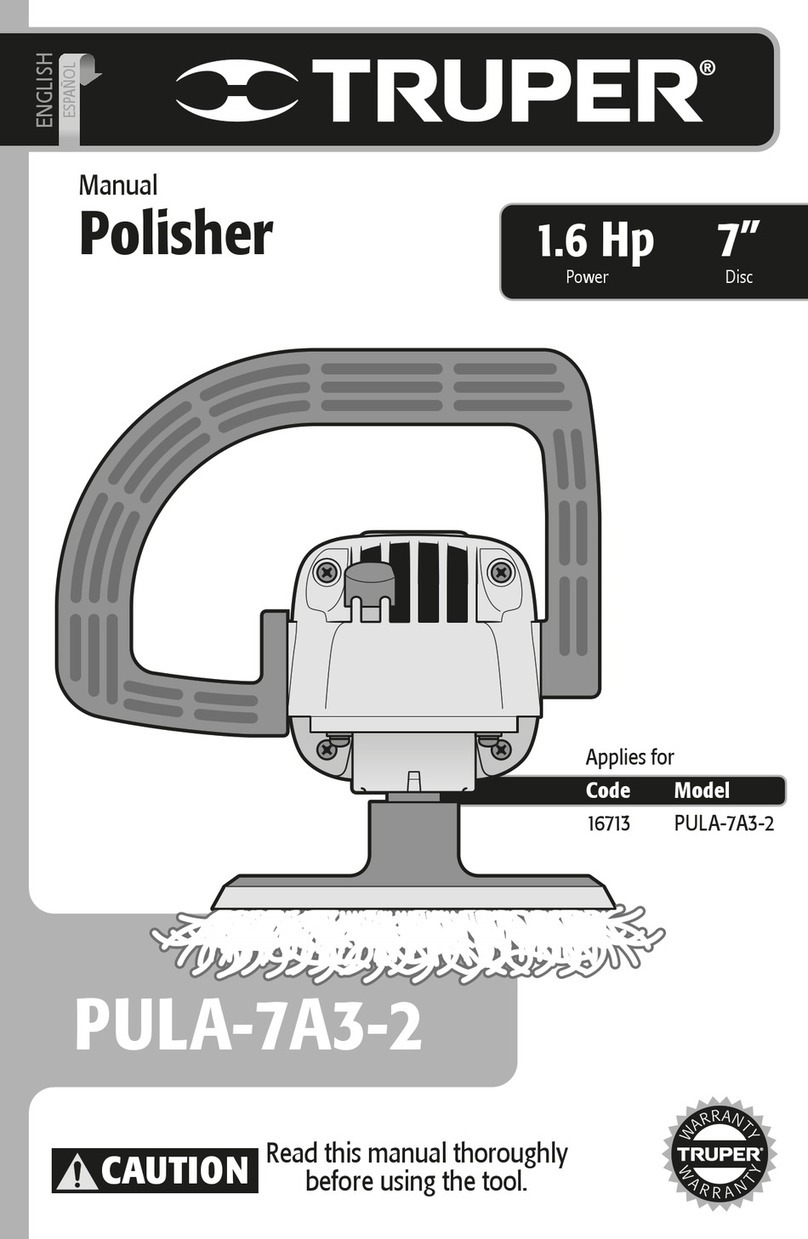
Truper
Truper PULA-7A3-2 User manual
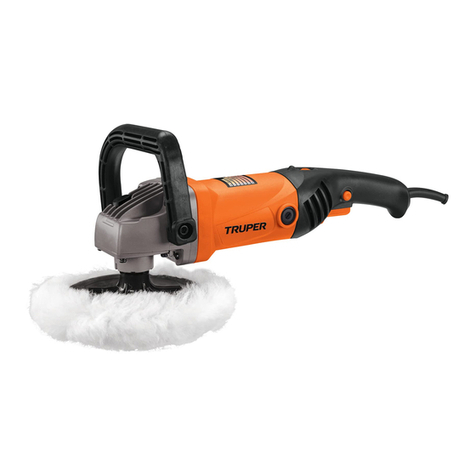
Truper
Truper PULA-7A3-2 User manual

Truper
Truper LIOR-1/4A2 User manual
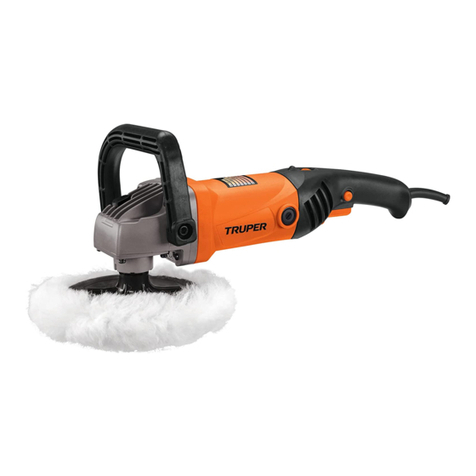
Truper
Truper PULA-7A3 User manual
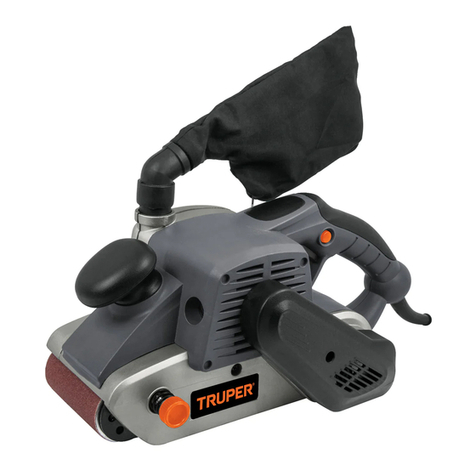
Truper
Truper LIBA-4X24N2 User manual

Truper
Truper PULA-7N User manual
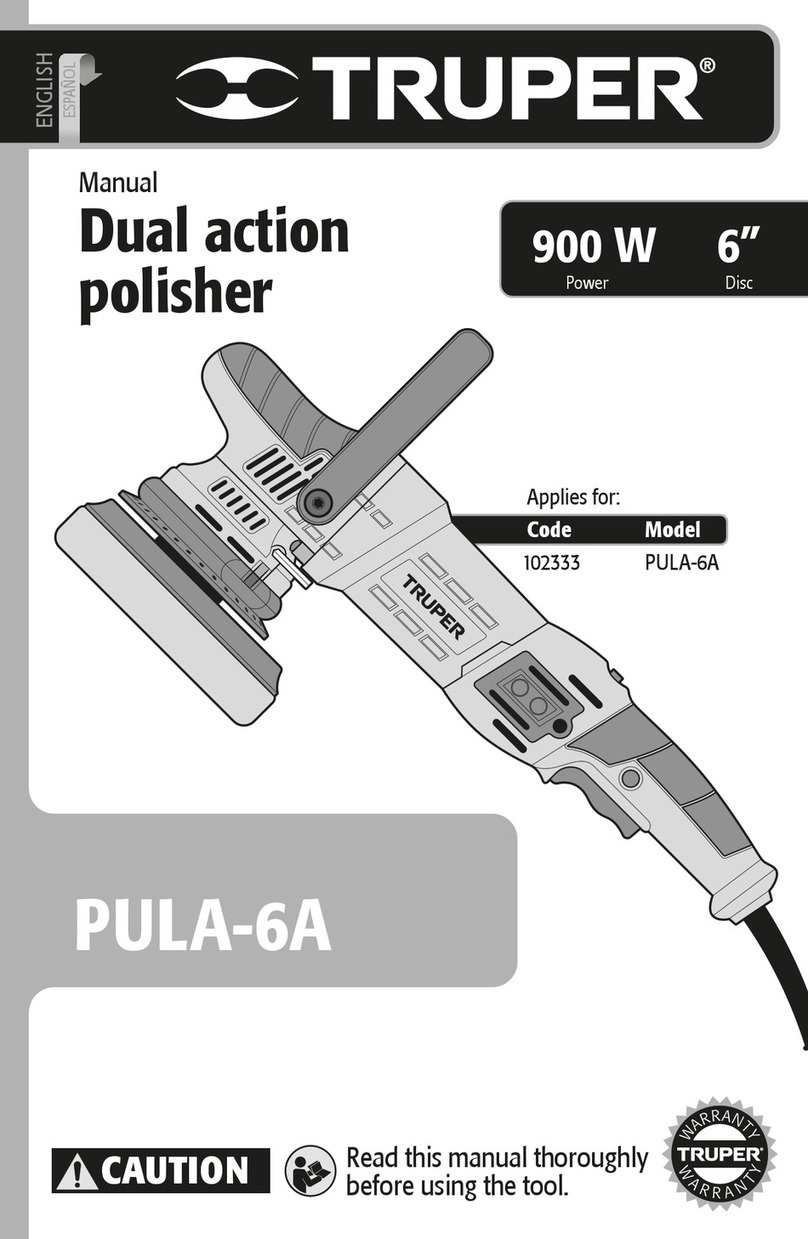
Truper
Truper PULA-6A User manual

Truper
Truper PULA-7A3 User manual

Truper
Truper LIRO-5A User manual
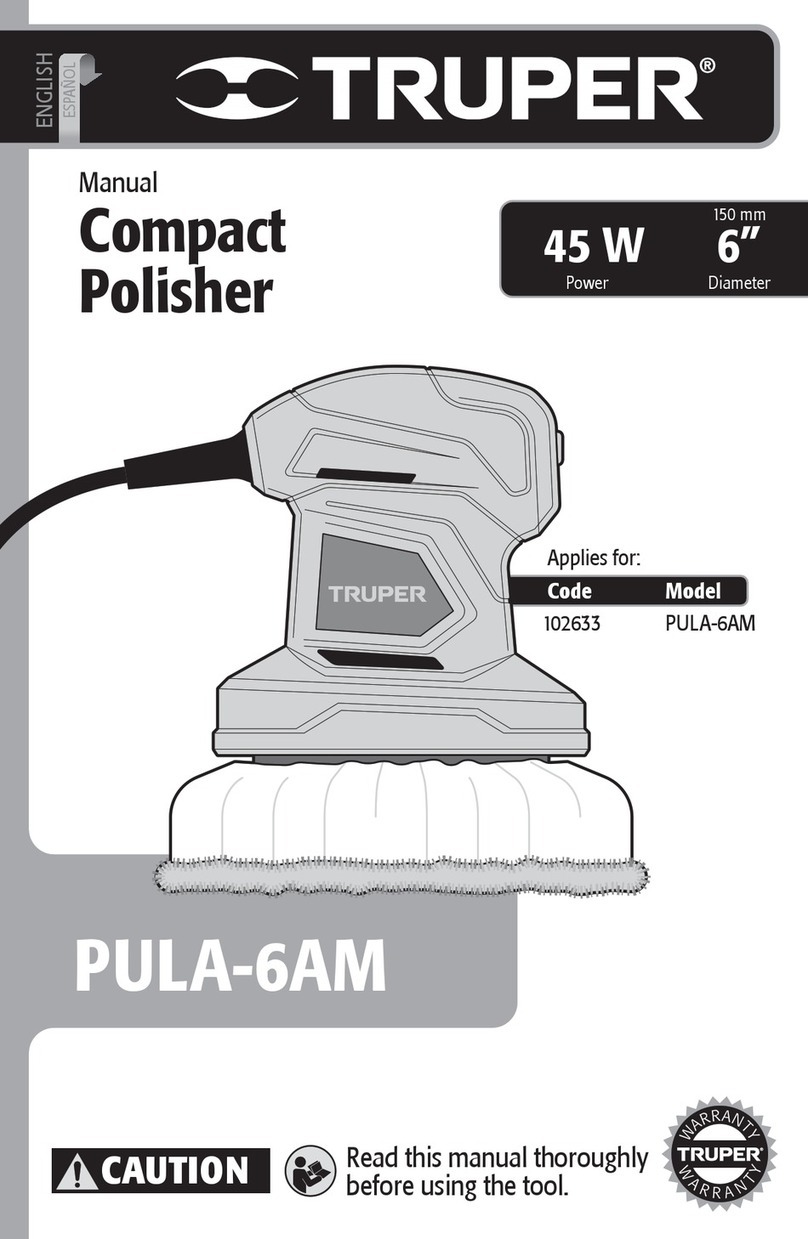
Truper
Truper PULA-6AM User manual
Popular Sander manuals by other brands
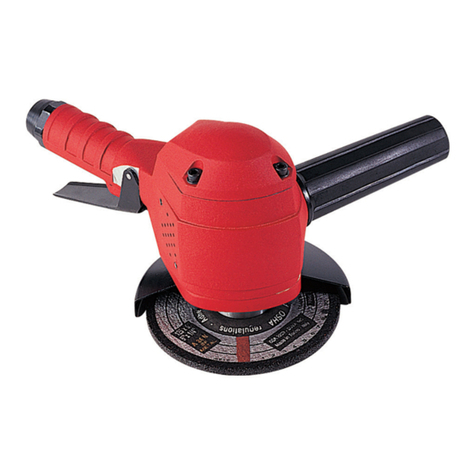
Desoutter
Desoutter KL1120A5 manual
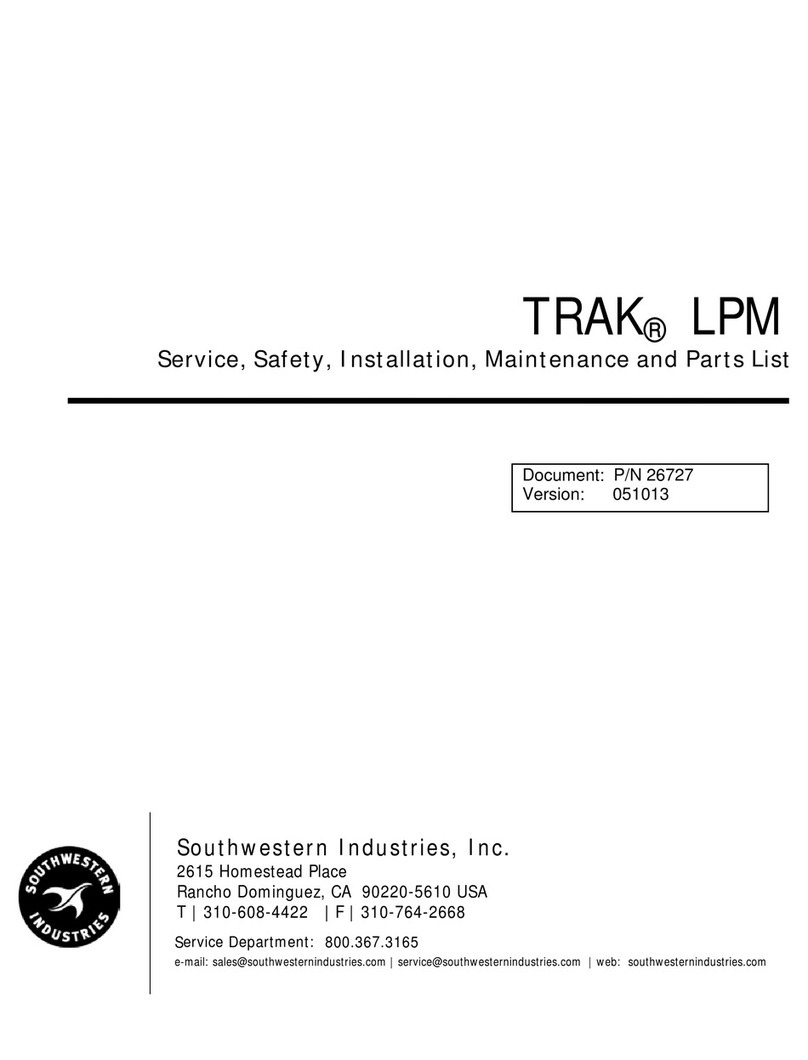
Southwestern Industries
Southwestern Industries TRAK LPM Installation, maintenance and user instructions
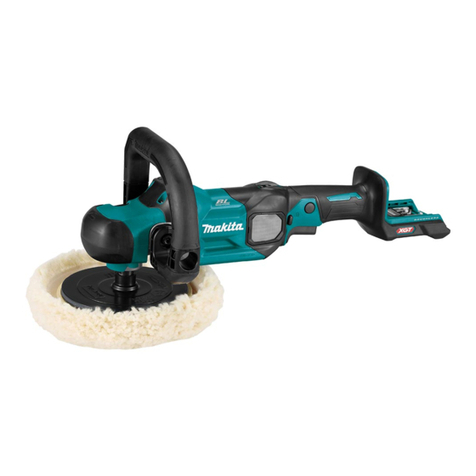
Makita
Makita PV001G instruction manual
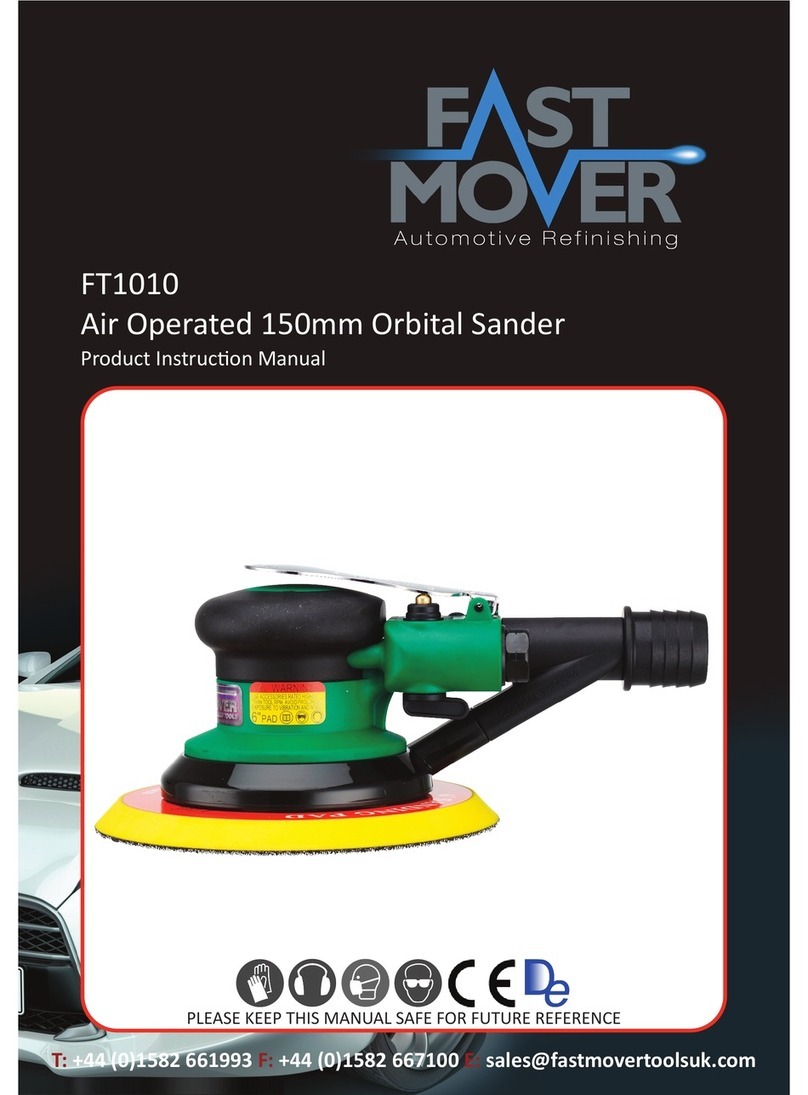
Fast Mover
Fast Mover FT1010 instruction manual

Milwaukee
Milwaukee 6021-21 Operator's manual

PEUGEOT
PEUGEOT EnergySand-200ASP using manual
